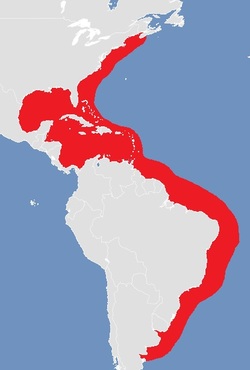
Common Name
Sixgill Shark
Year Described
Bonnaterre, 1788
Identification
A large shark with an elongate body, broad head, and large mouth. Dorsal fin is small and placed far back on the body anterior to the anal fin base. Distance between the dorsal and caudal fin base is equal or slightly greater than the length of the dorsal fin. Anal and pelvic fins are similar in size. Caudal fin is large with a poorly developed ventral lobe and a moderately developed sub-terminal notch. There are six long gill slits; the last ends anterior to the pectoral fin origin. The mouth extends past the posterior margin of the eye. The upper jaw has small yet sharp teeth and the lower jaw contains long, comb-shaped teeth in six rows. The eyes are relatively small.
Color
Gray, brown, brownish-tan, or blackish with a lighter belly. The trailing edges of the median fins are often lighter. The lateral line is also light in color. There are occasionally dark blotches on the flanks. Eyes are blue-green in life.
Size
Mature adults from 300 – 420 cm. Maximum size to 480 cm. possibly over 500 cm. Males mature at a smaller size than females.
Habitat
Found offshore over continental shelves and slopes from 500-1100 m. May be found deeper (~2000m.) or shallower (in cooler waters). A slow swimmer but capable of strong bursts of speed. Feeds on bony fishes and other sharks. Ovovivparous (22-108 young).
Range Map

Range
Bermuda, North Carolina to Florida on the Atlantic coast, Florida to E. Mexico in the Gulf of Mexico. Scattered records in the Caribbean, mostly on the continental coasts (Central America), also Cuba and Venezuela. Also found in the southwest Atlantic (Brazil, Uruguay, Argentina).
References
Castro, J.I. 2011. The Sharks of North America. Oxford University Press, 640 pp.
Compagno, L., M. Dando, and S. Fowler. 2005. Sharks of the World. Princeton University Press, 480 pp.